Let’s begin a new exciting journey and explore the jewels of the richest man in the world; Mir Osman Ali Khan Siddiqi, Asaf Jah VII (6 April 1886 – 24 February 1967), the last Nizam of Hyderabad, he ruled Hyderabad between 1911 and 1948 until India annexed it.
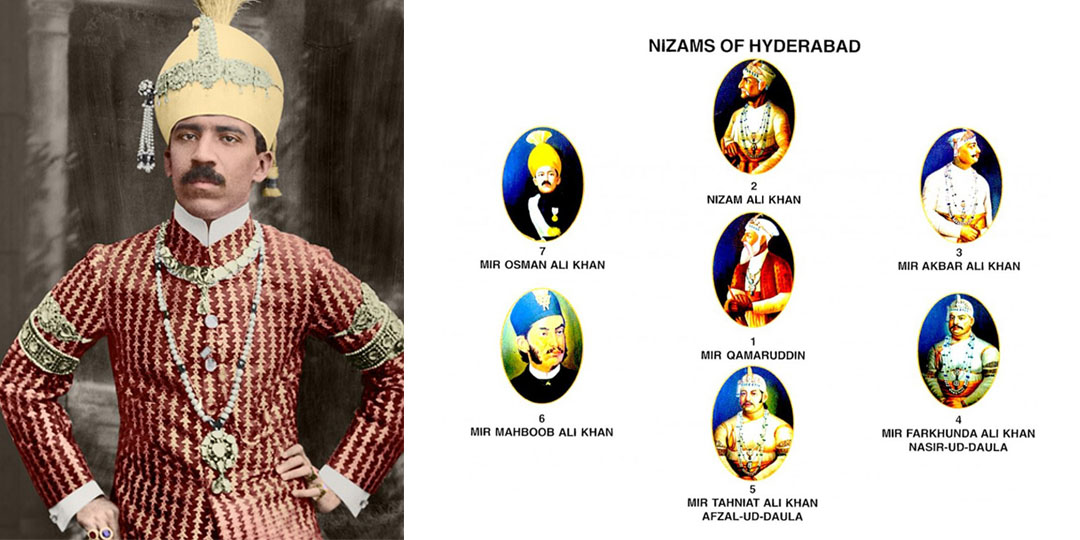
The Nizams were the 18th-20th century rulers of Hyderabad. “Nizam of Hyderabad” was the title of the monarch of the Hyderabad State. NIZAM, shortened from Nizam-ul-Mulk, meaning Administrator of the Realm was the title inherited by Asaf Jah I.
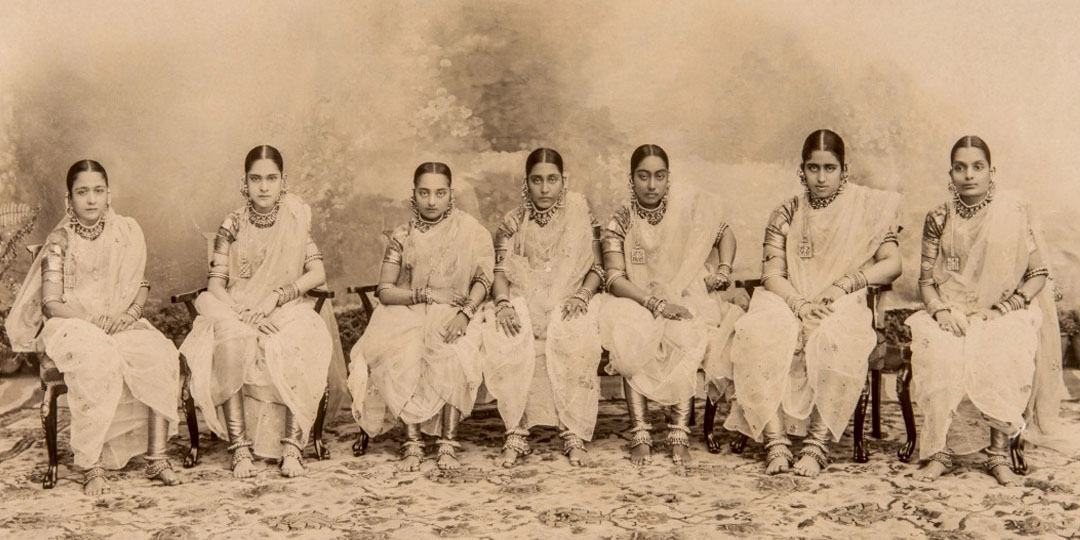
They were very fond of buying many kinds of jewels and gems and soon became to be known as the greatest buyers in the market. The gemstones Emerald, Ruby, diamonds had a different name during the Nizam time as below:
Diamond – KANWAL.
Uncut Diamond – ALMAS.
Briolette – GOSHWARA.
Ruby – YAKUT.
Emerald – ZAMRUD.
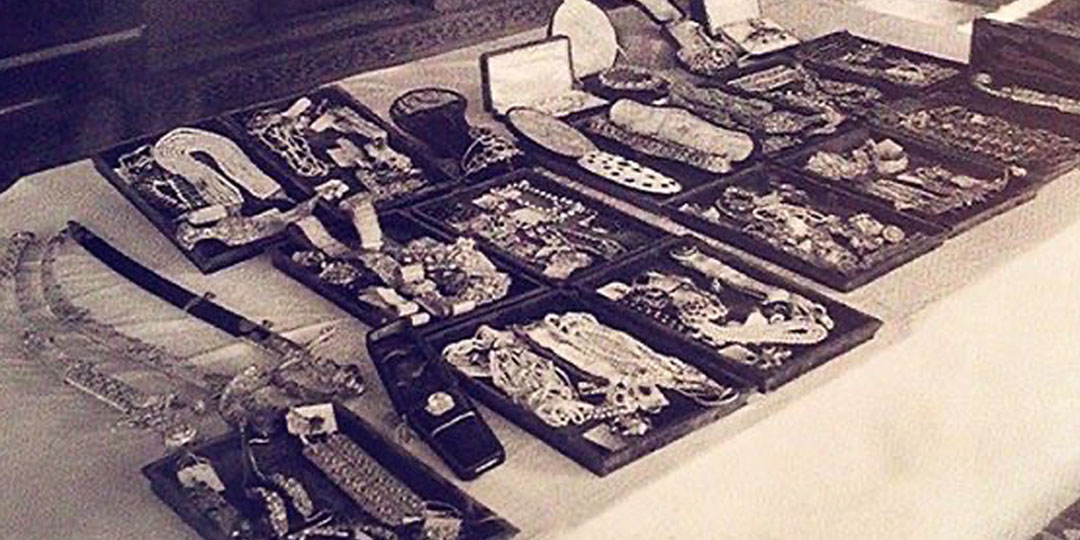
Soon after India’s independence and the annexation of the erstwhile princely state of Hyderabad, the 7th and the last Nizam, Mir Osman Ali Khan, created 54 trusts. The jewels, now in the custody of the Indian government, were part of the assets of these exclusive trusts. In 1995, the Indian government finally acquired a part of the inventory for Rs. 217 crore. Twelve years later, the National Museum in Delhi exhibited the priceless jewellery collection of the Nizam of Hyderabad in 2019.
Let’s explore the different kind of jewels adorned by the Nizam and his Begum (wives), inspired by the Deccan, Mughal and the European style of craftsmanship.
THE JACOB DIAMOND:
One of the famed pieces that belonged to the Nizam of Hyderabad is THE JACOB DIAMOND.
The story goes, when Osman Ali Khan found the diamond in the toe of his father’s shoe at the Chowmahalla Palace, he used it as a paperweight for a long time until the diamond’s true value was realised.

The Jacob Diamond is also known as “Imperial Diamond” or “Victoria Diamond”, was first discovered in the Kimberly mines of South Africa and was assumed to be one of the biggest diamonds in the world at that time, weighing approximately 457.5 cts. In the 19th century, it was first smuggled from London to Amsterdam, where it was cut into a slightly oval-shaped, 58 faceted diamond, weighing 184.50cts. Several negotiations and a court case later, the diamond was sold to Nizam VI by Malcolm Jacob from Simla in 1892.
Content Credit: Tilfi Blog.
HEAD ORNAMENTS:
SARPECH: It is also known as an aigrette, is a turban ornament that was worn by significant Hindu, Sikh and Muslim princes. Sar means head or front, and pech means screw. Hence, the word Sarpech literally means that which is screwed onto the front (of the turban). The Sarpech, adorned by the Nizam, was made in the 18th-19th century. The jewels are set in open-back mounts which is a combination of Indian and European design sensibilities. The Columbian emeralds are representative of the Nizam’s fascination for the gem which makes up for a large part of the jewellery collection.
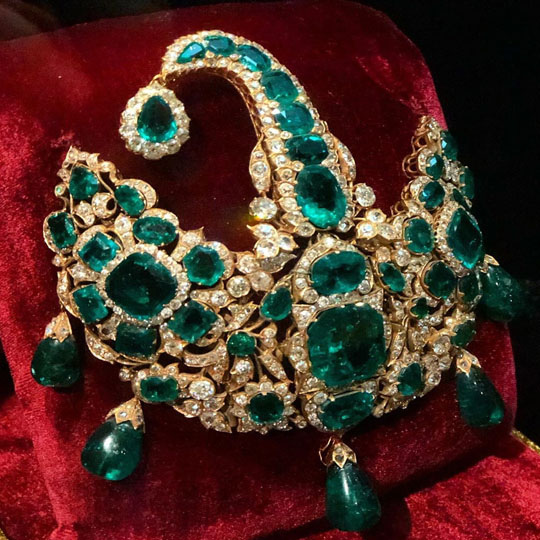
Featured above is “Sarpech Khurd Zamarrud Wa Kanval Almas” with table-cut emerald in the centre surrounded by uncut diamonds, set in gold and decorated with square, rectangle, round and oval emeralds matched for their colour, lustre and purity along with emerald drops.

Magnificent Sapech in Emeralds, Ruby and Diamonds.
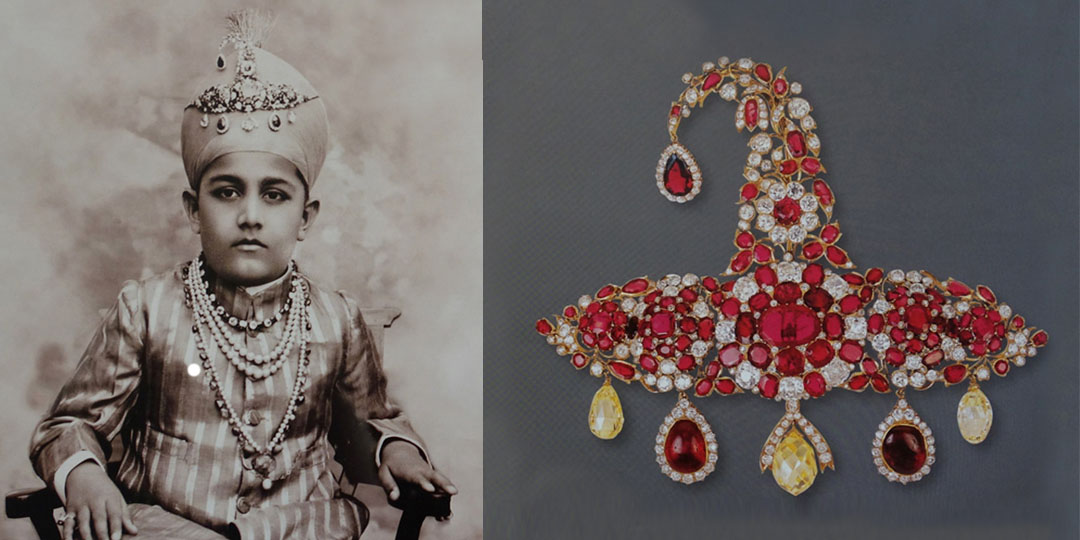
Prince Azam Jah wearing a Pigeon Red Ruby Sarpech, with more than 100cts of Ruby, the three large Golden Yellow briolette diamonds weighs appx 65cts. This Sarpech can be separated into six smaller jewels such as Pendant, Brooch and head ornament. Blog.
KALGI: This is a turban ornament, worn with feather tuft or plume.
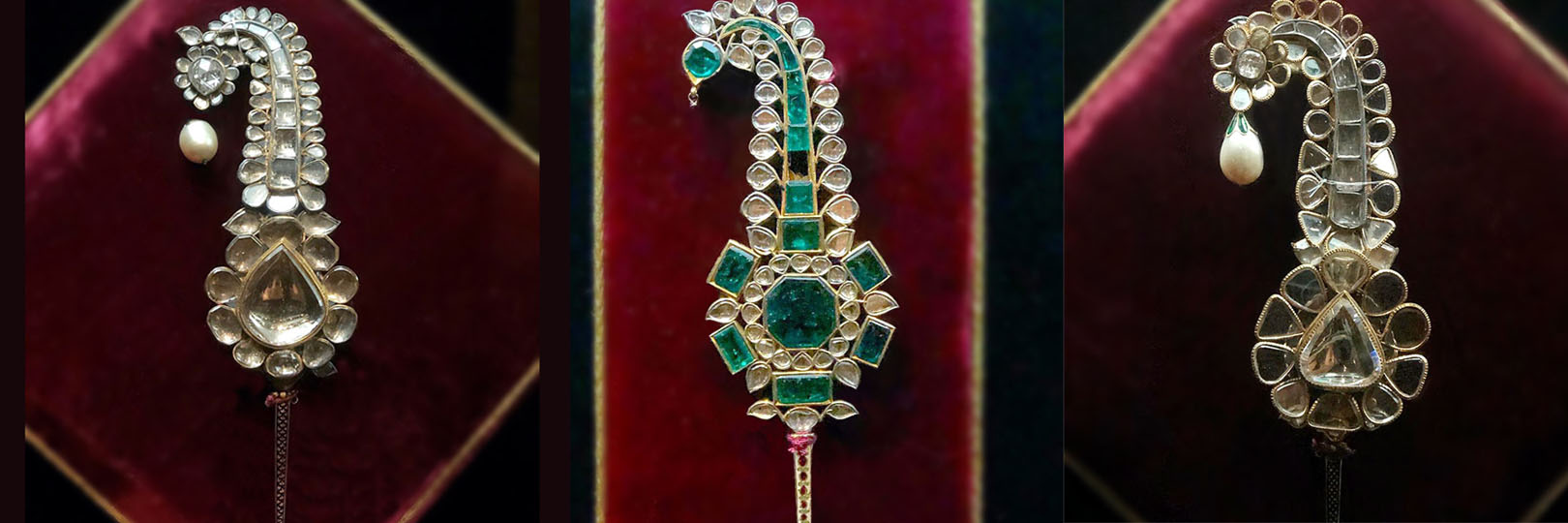
Featured above is Enamelled turban ornament set with Colombian emeralds and Golconda Diamonds.
TURRA: This is a turban ornament, in the form of a stemmed rosette, with suspended free-hanging strings of Gemstones or pearl.
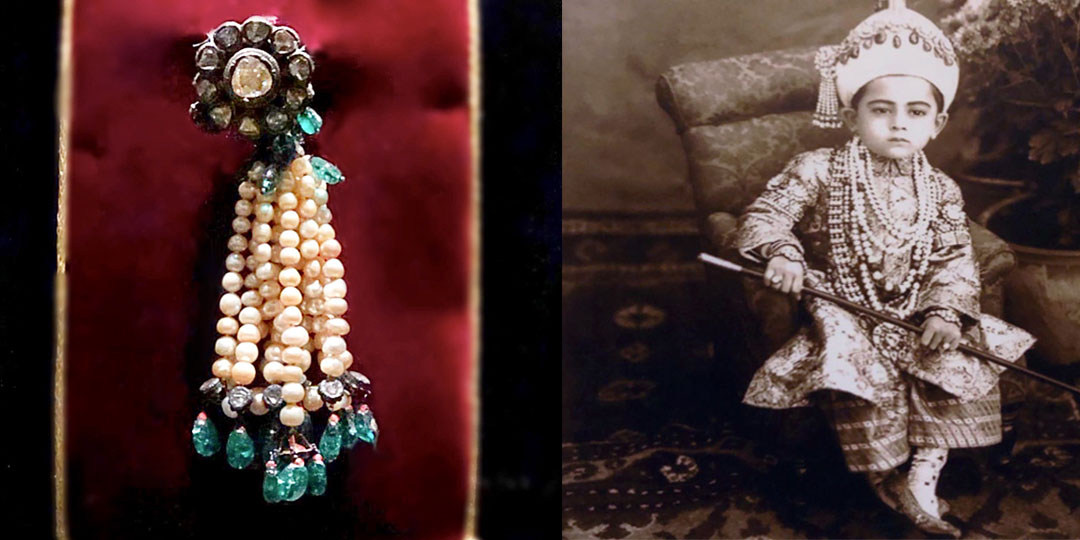
Featured above is Sarpech Murassa -wa-Turra (Part of the Sarpech).
Prince adorned with magnificent jewels, crafted during the 18-20th century.
NECKLACES:
EMERALD NECKLACE: Nizam of Hyderabad has, indeed, left a rich legacy for the country that share beautiful stories about rich Indian artistry and unmatched lifestyle. Let me take you through some of the magnificent necklaces.
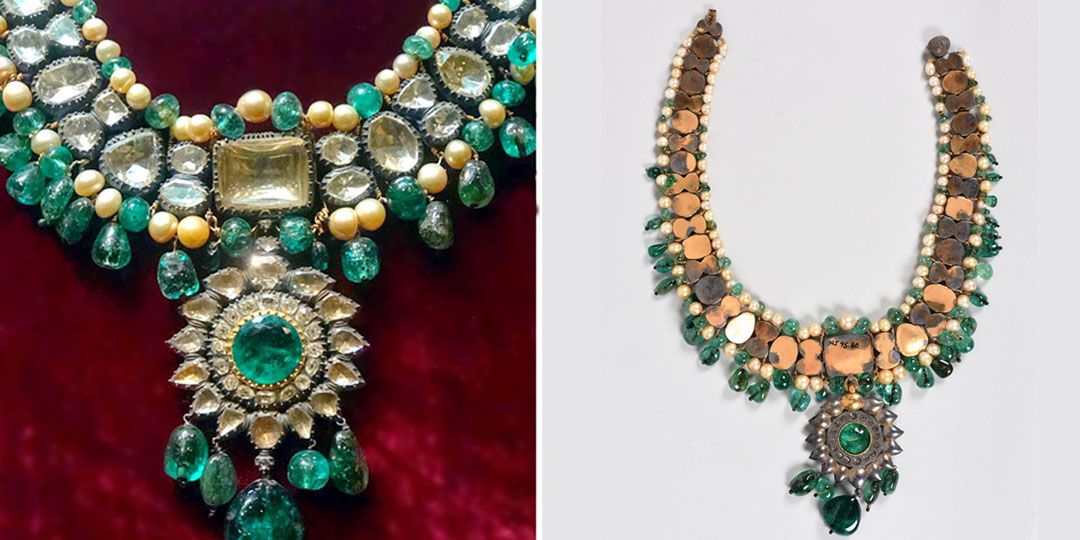
Featured above is a 19th-century necklace inspired by the Deccan workmanship, known as “PACHCHIKAM” made in silver & gold, embellished with Emeralds, Diamonds and Pearls.
Pachchikam in Hindi means peeche or back; this type of jewellery has gold on the rear and silver in front. The overall appearance of Pachchikam comes across as rather delicate and unfinished. Silver being extremely malleable, and having a close resemblance to platinum, is used in the craftmanship. The craft owes its origins to Gujarat and Kutch, though it’s been originally inspired by early European designs worn by the nobility in the 16th century. A few pieces in the Nizam’s collection are attributed to this technique, to show the brilliance of the diamonds used.
Credit: Gramho Blog.
UNCUT DIAMOND NECKLACE:

Featured above is a one of a kind necklace embellished with 21 Uncut Golconda Diamonds, weighing 240cts and Natural Basra Pearl, 19 century.
PEARLS AND DIAMONDS: The Nizam of Hyderabad had the widest collection of Natural Pearls jewellery. It is believed that the pearls that he had accumulated could fill up the “Olympic Size Pool.”
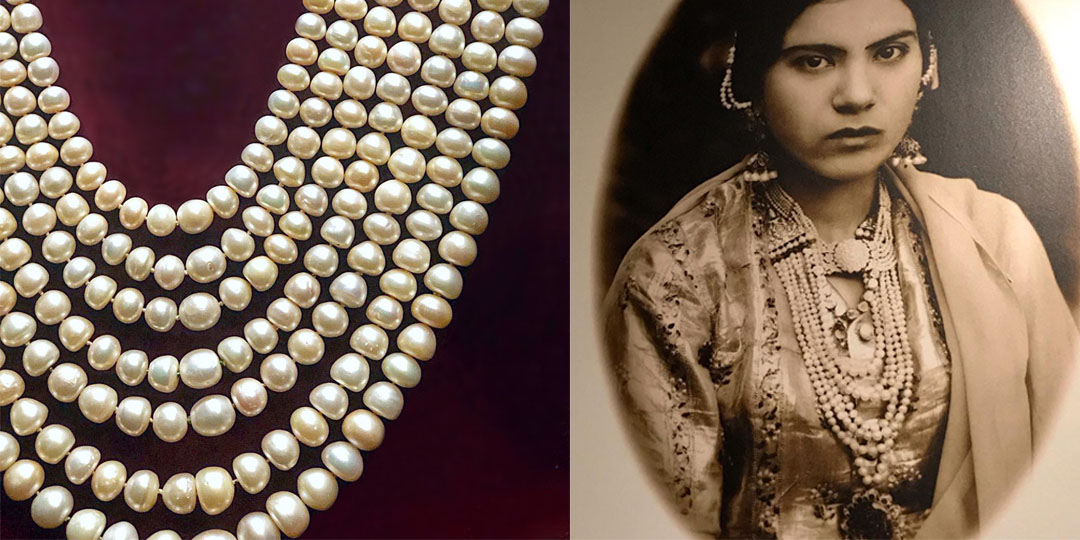
The story goes, The Nizam loved natural pearls, so when the pearl dealers came to Hyderabad along with their collection to offer; each pearl being of a different colour, shape, size and make; made it difficult to design a piece of jewellery. Therefore, The Nizam kept on collecting Natural Pearls until they could be symmetry crafted into an ornament. This created a market of pearls in Hyderabad, giving it the title, “City Of Pearls.” Even till today, Hyderabad is the market of trading of Natural Basra Pearls.
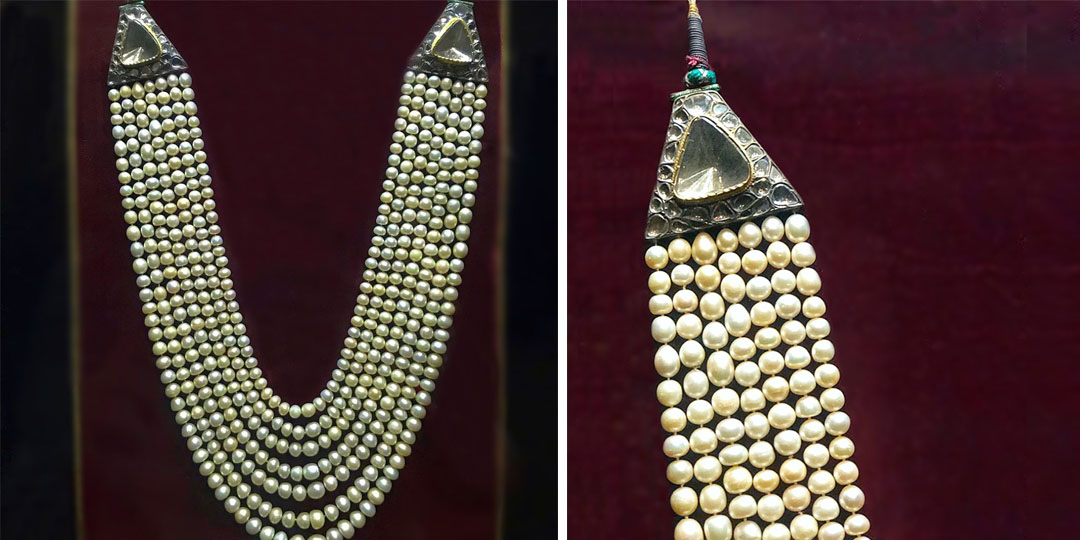
Featured above is Sutlada Moti haar, a beautiful seven string necklace with 465 Basra pearl and a diamond clasp with a triangular shape polkis, called “Samosa”.
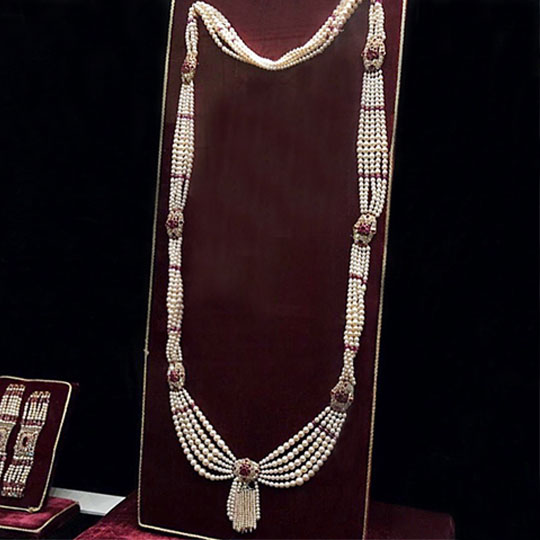
Featured above is five strand pearls necklace with gold panels set with diamonds and rubies.
The Nizam of Hyderabad had one of a kind Golconda Diamonds jewellery; these diamonds are mined in a specific geographic area in the present-day Andhra Pradesh and Telangana states of India, the territory belonged to the Nizam of Hyderabad. Therefore all Golconda diamonds known today were mined in his kingdom. Out of 38 diamond mines of India, 23 were located in the Golconda Sultanate, making it the ‘Diamond Capital’ of the past. It was considered a point of pride by any ruler to be the owner of one of the Golconda Diamonds.
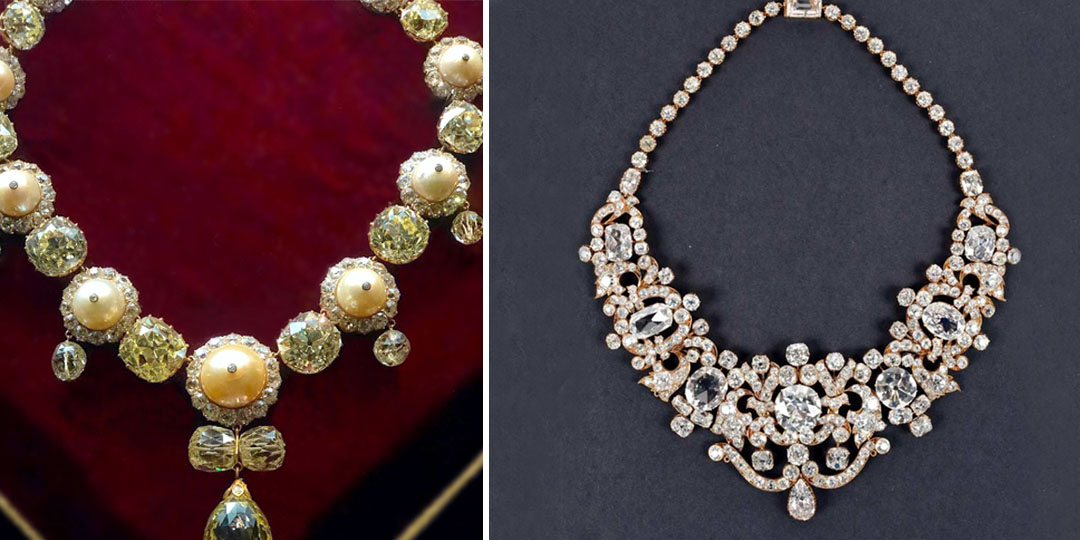
Featured above is to the left is “Kanthi Marvareed Kanval Almas Mai Padak Necklace”, late 19th century set with diamonds, pearls diamonds beads and briolette diamond drops.
Featured to the right is: “Kanthi Almas Kanval” a late 19th-20th century Gold Diamond Necklace, which is among the foremost masterpieces of the Nizam’s collection, inspired by the European designs. It is set with Golconda diamonds in an intricate pattern with large circular and oval diamonds in the middle surrounded by smaller diamonds and a pear-shaped diamond hanging from the middle. The chain is also embedded with a series of diamonds, and the clasp is a large rectangular diamond. The diamonds are set in an open-back mould to allow for easy passage of light to illuminate their brilliance. The necklace shows the hallmark of Indian craftsmanship, for every single diamond in the necklace, is of different shape and size, yet the overall necklace is perfectly balanced and perfectly symmetrical.
The Nizams were said to have more jewellery than all the princely states of India put together. They were indeed true connoisseurs of jewellery and craftsmanship. Their lifestyles and traditions are manifested in their magnificent palaces, the luxurious objects they used and most of all in their jewels.
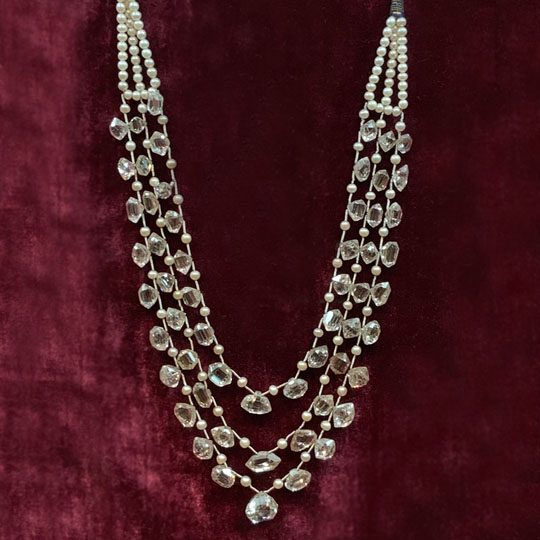
Featured above is a truly remarkable Diamond and Natural Pearl Necklace, with the diamond cut in the shape of Taveez. A Taveez is a locket that is generally associated with Islam, also called as an amulet or a Talisman. It usually contains verses from the Quran or other prayers and symbols inscribed on the metal portion. It is worn by Muslims to protect them from evil and also believed to bring good luck.
BELTS:
Post the demise of the Mughal empire, and the Nizams had adopted a European lifestyle and often wore western-influenced clothes such as high collared coats, which allowed the Nizams with fewer opportunities to display their opulent jewels. Hence, they wore adornments like belts or elaborate headgears, which became an indispensable part of the Nizams’ jewellery collection. It was mandatory in the Nizams court to wear a belt around their JAMA.
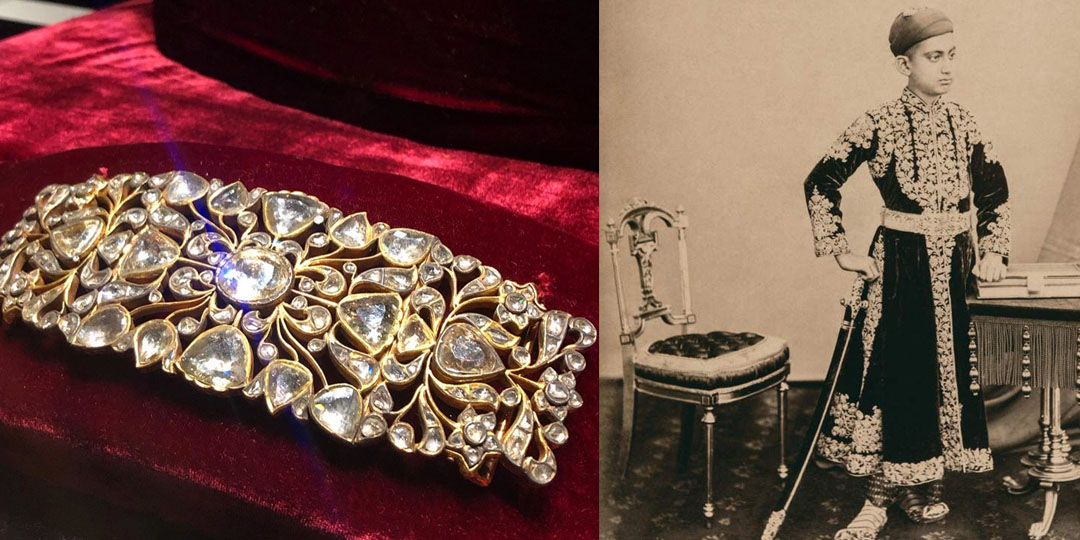
Featured above is “Baglus Almas”, a gold buckle set with diamonds of the late 18th century. The buckle is made of gold and inlaid with large and small diamonds in a floral pattern, set in the Kundan style. The buckle consists of three pieces joint together which can be adjusted to fit the waist. The reverse of the buckle is covered with sheet gold carved with floral motifs, representative of Deccan workmanship. The second image features, 15-year-old Mir Mahboob Ali Khan, wearing belt buckle studded with Golconda Rose Cut and diamonds and posing for the coronation.
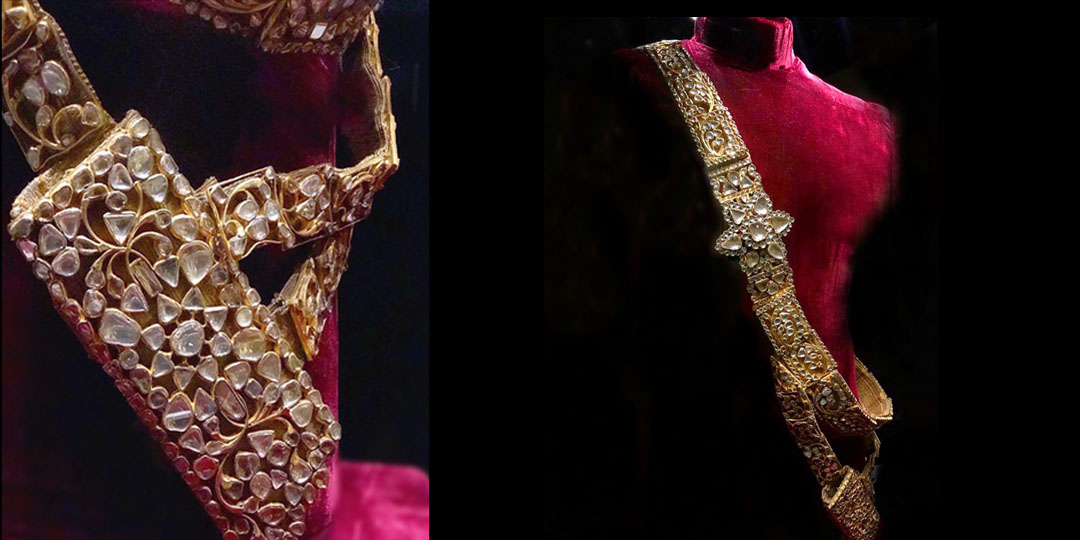
Featured above is “Baglus Almas Parab Partalanuma”, a shoulder belt and dagger set with Golconda diamonds.
Most of the jewels of the Nizam were crafted in India; however, the belt featured below, was made by French jewellers at the 19 century. This was the only jewellery which was made, outside the country where the diamonds were provided by the Nizam. Belt encrusted with golden coloured Golconda diamonds. Although a few diamonds are missing, the beauty and craftsmanship relay such panache!
POCKET WATCH:
The time of the Nizam was as valuable as his jewels, and he wore his TIME in his POCKET!!
Nizam of Hyderabad wore his Pocket Watch with a lot of grace, with multiple attached chains to allow them to be secured to a waistcoat, lapel, or belt loops, to prevent them from falling loose. The pocket watch and the chains had a European influence, made between 18-19 century. European influences, essentially from Paris and London, were particularly strong in the early 20th century. One of the instances can be seen in the use of pocket watches, which ultimately became a part of the ceremonial regalia of Indian royalty.

Featured above is “Ghariyal Jaravi Meenakari”; Enamelled Watch with diamonds, Calcutta, late 19th century, with the chains decorated with Golconda Diamonds and Natural Pearls, and the dial is embellished with diamond and enamel work.
JEWELS ADORNED BY THE BEGUMS!
I’m bringing back the female power! Yes! You guessed it right. I will be talking about the jewels adorned by the BEGUMS(wives) of the Nizam of Hyderabad.
ZADAVI LACHA OR CHINTAK – CHOKER:

Featured above is “Zadavi Lacha or Chintak” which is a closed neck Choker. These chokers were crafted in one of a kind precious gemstones and Golconda diamonds during 18-20 century.
Image 1: Sapphire choker necklace.
Image 2: Natural Pearls and Diamond choker necklace.
Image 3: A ‘Guluband’ necklace, a hypnotic choker dripping with Colombian emeralds and Golconda diamonds.
JUGNI NECKLACE:
The “Zadavi Lacha or Chintak” was worn along with “JUGNI” necklace Jugni is a pendant that means Fireflies.
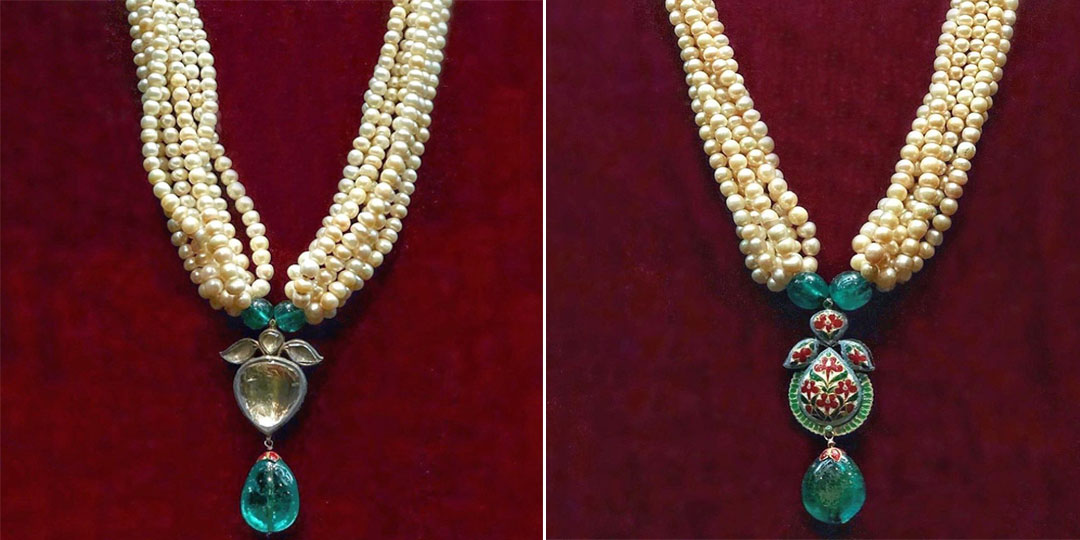
Featured above is a Jugni necklace made in 7 strands of Natural Basra Pearls and Uncut Diamonds, Emeralds. The backside has the treat to the eyes, with a beautiful white, red and green meenakari work, known as Karvani Meenakari, 18th century.
CHOTI TAVEEZ:
Begums, adorned Choti Taveez (Braid amulet), from the early 19th century, to protect from the evil eyes.
CHOTI means Braid.
TAVEEZ means amulet.
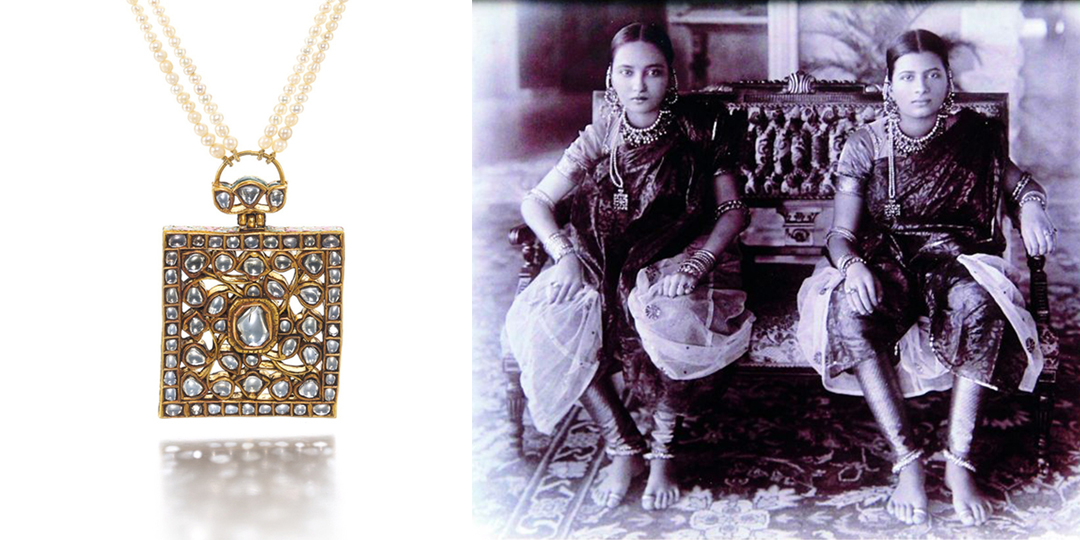
It’s square shape, studded with Golconda flat cut diamonds on both the sides; strung on Natural Pearl and suspended from the hair, laying over the right shoulder. All the women of the family wore Choti Taveez. In the current days, the Choti Taveez are worn as pendants.
EARRINGS:
The earrings adorned by the Begums were flower-shaped earrings called KARAN PHOOL, decorated with enamel, studded with Uncut Golconda Diamonds, and Basra pearls.
KARAN means EAR.
PHOOL means FLOWER.

Image 1: Featured above are a pair of Antique diamond Natural Pearls and enamel Karan Phool earrings, set with pear and oval-shaped table-cut diamonds, early to mid-19th century, with modern fittings.
Image 2: Pankhiyan Almas Enamelled earring set with Diamonds and Natural Pearls. Each of crescent is set with eleven graduating diamonds. The design is inspired by a traditional Indian, handheld fan (pankha).
ARMBANDS:
“BAJUBAND” or ARMLETS, also known as Ananta, Angada are a type of bracelet worn on the upper part of the arm. Originally, this piece of jewellery was only worn by men, as a masculine accessory. However, they are also adorned by women.
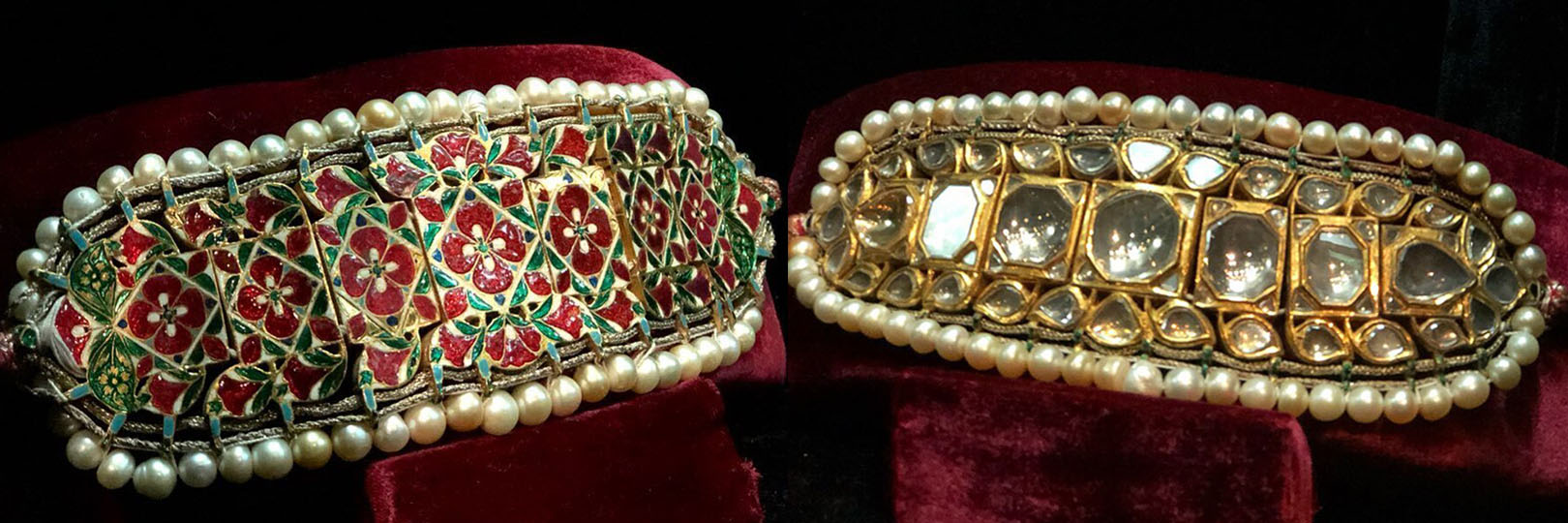
Featured above is “Bazuband Murassa” crafted in the early 18th century. Kundan-set with foiled table-cut diamonds; inside seven foliate panels, with exquisite enamel work.
These jewels are a symbol of royal patronage, royal ateliers, and fine craftsmanship! No wonder, they only added to the Begum’s demeanour.

Image 1: An exquisite enamelled Bazuband, set with Colombian emeralds and Golconda Diamonds.
Image 2: “Bazuband Parab Jaravi” Enamelled armbands set with Golconda Diamond and Natural Pearls.
Image 3: “Bazuband Almas Parab”; Diamonds set armband. The craftsmanship is a beautiful example of 18 century, the flat cut Golconda diamonds were set in silver, and the small petals are attached in the angle to look at the realistic flower. This bajuband is also known as Kiran Ka Bajuband with great enamel work on the reverse.
ANKLETS:
Anklets were worn primarily by women as an indicator of their marital status. They were gifted to the bride by the groom as a symbol of love and the wish to become her official husband.

Featured above are the gorgeous anklets adorned by the Begum, crafted in Deccan, 19th century.
Image 1: “Paizeb Murassa” Enamelled anklets set with diamonds and Natural Pearls.
Image 2: Anklet set with rubies, Golconda Diamonds and Natural Pearls.
Image 3: Paizeeb Yakhoot-wa-Almas-wa-Marvareed.
Besides the Nizam and his Begums, these magnificent jewels were also adorned by the young Prince. Safe to say, the fondness for jewels runs in the family.
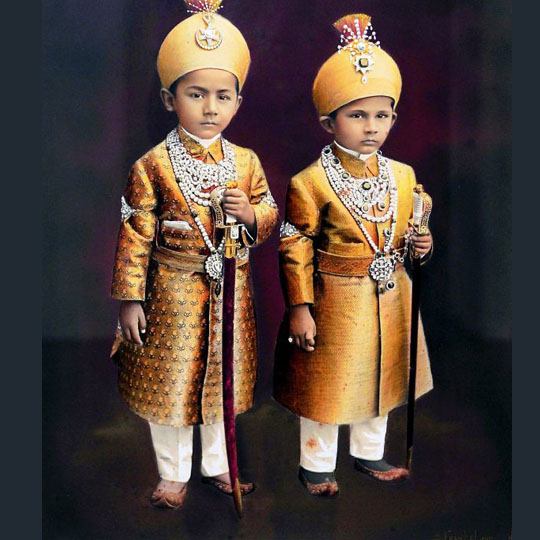
Prince Azam Jah and Prince Moazzam Jah, sons of Mir Osman Ali Khan, Hyderabad 1911, adorned in stunning jewels!
The lifestyle and a few some pieces of jewellery were influenced by Mughals, the former rulers of the region. How mesmerised are you by such beauty and finesse of the 18th-20th century jewels by the Nizam Of Hyderabad?
These work of art are so opulent and breathtaking that you just can’t stop admiring them!

Very informative 👍
Thank you!
Interesting pictures. The two young girls in the black and white picture, sitting down, are they wives or daughters? Just curious…😊
Hello! Those are Nizam Of Hyderabad’s son 🙂
quality information People are bound to find this really important. I had no clue on some of the things you mentioned earlier, thanks!
My pleasure! The treasures of Indian Maharajas
Wow that was unusual. I just wrote an really long comment but
after I clicked submit my comment didn’t show up. Grrrr…
well I’m not writing all that over again. Anyway, just
wanted to say superb blog!
Thank you Benny!